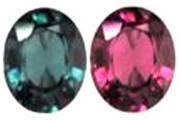Description Alexandrite is the color-change variety of the mineral chrysoberyl. Green in daylight or fluorescent light, alexandrite is red to purplish red in incandescent light or candle light. History The Most Expensive of All Gemstones Large deposits of alexandrite were found in the Ural Mountains of Russia in 1830. The Ural Mountain alexandrites displayed vivid hues and dramatic color changes. Since alexandrite mimics the red and green of the Russian flag, it held special significance for Russian people and was named for the young Czar Alexander II. The Ural Mountain deposits did not last long and today most alexandrite comes from Brazil, India, Madagascar, Sri Lanka and Tanzania. The 19th century alexandrites set the standard for fine quality, and newer alexandrites tend to be muddier and have a less dramatic color change. Some Ural Mountain alexandrites still exist in estate jewelry. Rare, high-quality alexandrite is the most expensive of all gemstones. Folklore Alexandrite is thought to protect hikers and mountain climbers to dispel the negative energy of others and to enable its wearer to foresee danger. Dreaming of Alexandrite In Victorian times, dreaming of alexandrite foretold of a time of need. Symbolism Day: Friday Birthstone, modern: June Season: Summer Anniversary, traditional: 55th Angel: Annael Country: Russia |
|



